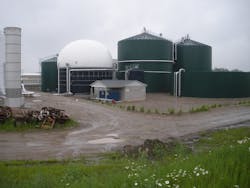Canadian Project Illustrates Potential of Biogas to Provide Green Power
London, ON, with population about 366,000, will this year see the launch of the privately owned Harvest Power Mustang Generation Limited plant that will process more than 15 different waste streams into biogas to generate electricity as well as dry bio fertilizers.
The 4.5-hectare plant—incorporating a Global Water Eng. (GWE) RAPTOR (rapid transformation of organic residues) system—harvests waste such as grocery store rejects, kitchen and market waste, food processing residues, leachate, manure and slaughterhouse residues, which it converts into enough biogas (primarily methane) to generate 2.85 MW of electricity and 8.7 tons a day of dry bio fertilizer.
The biogas replaces fossil fuels typically used to generate electricity. This plant’s biogas production of more than 27,000 normal cubic meters a day at 62.5% methane is equivalent to 20,000 kg a day of fuel oil, or 7,300 tons of the fossil fuel a year, worth nearly $6 million ($4.39 million Euro) a year.
GWE’s RAPTOR is a liquid-state anaerobic digestion process that consists of enhanced pre-treatment followed by multi-step biological fermentation. In the Harvest Power application, it is integrated into a process that begins with waste reception and storage, de-packaging and conditioning, and the removal of contamination such as plastics, metals and glass. It then undergoes thermophilic acidification, anaerobic digestion by the RAPTOR process, post digestion, aerobic treatment of the liquid part of the digestate, sludge conditioning and drying. This is followed by biogas sweetening (removal of hydrogen sulfide), drying and then use in combined heat and power (CHP) systems and engine generator sets of 2.85 MWe feeding back into the local electricity grid.
The RAPTOR process consumes 76 % of the potentially environmentally harmful chemical oxygen demand (COD) content of the waste, which comprises content of natural origin that can be broken down into biogas by anaerobic bacteria.
RAPTOR plants of the type installed at London, ON, produce green energy from a wide range of organic residue types, and are particularly applicable to such applications as:
- Food waste, such as market surplus, kitchen waste, off specification fruit and vegetables, and excess crops
- Agro-industry residues, like starch and sugar pulps, vegetable or potato waste.
- Industrial residues, such as brewery waste (spent grain), fruit processing waste, and paper mill sludge.
- Energy crops, for example corn (silage), various grasses and algae.
